In this guest post, Dominic McDevit-Parks, User:Dominic, reports on his work as the first Wikipedian in Residence at the National Archives and Records Administration. A Wikipedia contributor since 2004, Dominic is studying history and archives management at Simmons College.

In the 1940s, Ansel Adams, the famous American landscape photographer, was commissioned by the US Department of the Interior to photograph the country’s national parks. As a result, these photographs by a major 20th-century artist entered the public domain as federal works, and eventually became part of the records held by the National Archives and Records Administration. However, despite the fact that these photographs are part of the world’s shared cultural heritage, they had never truly been freely accessible to the public in all their glory. For decades, they were simply a physical collection of prints housed in the National Archives, until the late 1990s when the National Archives digitized the photos as part of its Electronic Access Project. They made their way into the National Archives’ catalog, were given an online finding aid, and were placed into their own Flickr album. In these three cases the images made public were scaled-down versions made for the web. They were, however, accompanied by advertisements encouraging interested users to purchase high-quality prints of the photos, and presumably this potential source of income served as a deterrent for releasing high-resolution digital scans. This tale should teach us an important lesson: that the public domain is not always public—even (sometimes especially) for works of incredible historical and artistic merit like these.
For Ansel Adams, there is a happy ending. The current incarnation of the National Archives, especially under the stewardship of David Ferriero, Archivist of the United States, has signalled a deep commitment to openness and free digital access to its holdings. It is also incredibly friendly to the cause of Wikimedia. One of the first things we worked on when I joined the National Archives as their Wikipedian in Residence was freeing the Ansel Adams collection, and this is something that they were very eager to accomplish. You can see all 220 photos now, in high resolution, on Wikimedia Commons, and the original TIFF files from the scans are going to be available soon. This is not a special case, though; the National Archives has put no restrictions on what we can obtain from their already-digitized files, and they would even like to work with any scanning volunteers to help digitize more.
I would also like to emphasize to the Wikimedia community that this is a two-way street. The National Archives can cooperate with Wikimedia because we share common goals like open access and public education, but they are reaching out specifically to us because we are in a unique position to add value to their holdings. We need to demonstrate our seriousness by following through as a community. This means incorporating new, high-quality images from the National Archives into Wikipedia articles so they don’t just languish unused and undiscovered, fully categorizing them on Commons, digitally restoring historical images, working to transcribe them on Wikisource, and even creating new content on Wikipedia to accompany and enrich National Archives documents. We can start this effort with Ansel Adams—and I encourage you to get involved with that project—but this is also hopefully only the beginning of a very fruitful collaboration.
You can get involved in the various projects at WP:NARA, WS:NARA, and COM:NARA.
Dominic McDevit-Parks
Wikipedian in Residence, National Archives and Records Administration

Can you help us translate this article?
In order for this article to reach as many people as possible we would like your help. Can you translate this article to get the message out?
Start translation